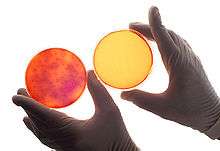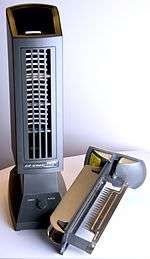Air ioniser

An air ioniser (or negative ion generator or "Chizhevsky's chandelier") is a device that uses high voltage to ionise (electrically charge) air molecules. Negative ions, or anions, are particles with one or more extra electrons, conferring a net negative charge to the particle. Cations are positive ions missing one or more electrons, resulting in a net positive charge. Most commercial air purifiers are designed to generate negative ions. Another type of air ioniser is the electrostatic discharge (ESD) ioniser (balanced ion generator) used to neutralise static charge. In 2002, Cecil Alfred 'Coppy' Laws was credited with being the inventor of the domestic air ioniser in an obituary in The Independent newspaper.
Air ionisers have been used to eliminate the occurrence of air-borne bacterial infections and to reduce static electricity buildup in electronics.
Ionic air purifiers

Air ionisers are used in air purifiers to remove particles from air. Airborne particles are attracted to the electrode in an effect similar to static electricity. These ions are de-ionised by seeking earthed conductors, such as walls and ceilings. To increase the efficiency of this process, some commercial products provide such surfaces within the device. The frequency of nosocomial infections in British hospitals prompted the National Health Service (NHS) to research the effectiveness of anions for air purification, finding that repeated airborne acinetobacter infections in a ward were eliminated by the installation of a negative air ioniser—the infection rate fell to zero, an unexpected result. Positive and negative ions produced by air conditioning systems have also been found by a manufacturer to inactivate viruses including influenza.[1]
The SARS epidemic fueled the desire for personal ionisers in East Asia, including Japan (where many products have been specialised to contain negative ion generators, including toothbrushes, refrigerators, air conditioners, air cleaners, and washing machines). There are no specific standards for these devices.[2]
Ions versus ozone
Ionisers are distinct from ozone generators, although both devices operate in a similar way. Ionisers use electrostatically charged plates to produce positively or negatively charged gas ions (for instance N2− or O2−) that particulate matter sticks to in an effect similar to static electricity. Even the best ionisers will also produce a small amount of ozone—triatomic oxygen, O3—which is unwanted. Ozone generators are optimised to attract an extra oxygen ion to an O2 molecule, using either a corona discharge tube or UV light.
At concentrations that do not exceed public health standards, ozone has been found to have little potential to remove indoor air contaminants.[3] At high concentrations ozone can be toxic to air-borne bacteria, and may destroy or kill these sometimes infectious organisms. However, the required concentrations are sufficiently toxic to humans and animals that the US FDA declares that ozone has no place in medical treatment[4] and has taken action against businesses that violate this regulation by offering therapeutic ozone generators or ozone therapy.[5] Ozone is a highly toxic and extremely reactive gas.[6] A higher daily average than 0.1 ppm (100 ppb, 0.2 mg/m³) is not recommended and can damage the lungs and olfactory bulb cells directly.
Adverse health effects
A number of studies have been carried out on negative ion generators. Some studies show that the ozone generated can exceed guidelines in small, non ventilated areas.[7] One study showed that ozone can react with other constituents, namely cleaning agents to increase pollutants such as formaldehyde (importantly, this study had as its objective the testing of the use of cleaning products and air fresheners indoors and associated health risks as opposed to adverse health effects of air ionisers). [8]
Consumer Reports court case
Consumer Reports, a non-profit US-based product-testing magazine, reported in October 2003 that air ionisers do not perform to high enough standards compared to conventional HEPA filters. The exception was a combination unit that used a fan to move air while ionizing it. In response to this report, The Sharper Image, a manufacturer of air ionisers (among other products), sued Consumer's Union (the publishers of Consumer Reports) for product defamation. Consumer Reports gave the Ionic Breeze and other popular units a "fail" because they have a low Clean Air Delivery Rate (CADR). CADR measures the amount of filtered air circulated during a short period of time, and was originally designed to rate media-based air cleaners. The Sharper Image claimed that this test was a poor way to rate the Ionic Breeze, since it does not take into account other features, such as 24-hour-a-day continuous cleaning, ease of maintenance, and silent operation.
The United States District Court for the Northern District of California dismissed the case, reasoning that The Sharper Image had failed to demonstrate that it could prove any of the statements made by Consumer Reports were false. The Court's final ruling in May 2005 ordered The Sharper Image to pay US $525,000 for Consumer Union's legal expenses.[9]
Electrostatic neutralizer in electronics
Air ionisers are sometimes used in places where work is done involving static-electricity-sensitive electronic components, to eliminate the buildup of static charges on non-conductors. Grounding with ground straps or other methods eliminates static buildup on conductors, but not non-conductors.[10]
See also
References
- ↑ McDowell, Natasha (3 January 2003). "Air ionisers wipe out hospital infections". The New Scientist (Daily news). Retrieved 24 August 2016.
- ↑ Natasha, Niece (1 July 2007). "Home Air Purifier: Technical Specification". For Healthy Air. Honeywell 50250-S. Retrieved 24 August 2016.
Type: HEPA Capacity: up to 390 square feet
- ↑ Woolston, Chris (21 April 2008). "Ionic purifiers' dirty secret". Los Angeles Times (THE HEALTHY SKEPTIC). Retrieved 24 August 2016.
- ↑ "TITLE 21—FOOD AND DRUGS; CHAPTER I—FOOD AND DRUG ADMINISTRATION DEPARTMENT OF HEALTH AND HUMAN SERVICES; SUBCHAPTER H—MEDICAL DEVICES". US Food & Drug Administration (FDA) website. Retrieved 2006-08-30.
- ↑ Kurtzweil P (1999). "Ozone generators generate prison terms for couple". FDA Consum. 33 (6): 36–7. PMID 10628316.
- ↑ "Ozone: Good Up High, Bad Nearby". Environmental Protection Agency (EPA) Website. Retrieved 2006-08-30.
- ↑ "Quantification of Ozone Levels in Indoor Environments Generated by Ionization and Ozonolysis Air Purifiers" (PDF). Air & Waste Manage. Assoc. 56:601–610. May 2006.
- ↑ "Indoor Air Chemistry: Cleaning Agents, Ozone and Toxic Air Contaminants" (PDF). April 2006.
- ↑ "Sharper Image pays $525,000 to end lawsuit against CU". Consumer Reports. 2006-08-06.
- ↑ "SCS - 963E - Benchtop Air Ionizers - Allied Electronics". alliedelec.com.
External links
| Look up ioniser in Wiktionary, the free dictionary. |
- New Scientist – Air ionizers wipe out hospital infections
- Do "corona discharge" devices alleviate asthma?
- NIOSH Immediate Danger to Life or Health (Ozone) Documentation
- Ionic Air Purifiers and Smog
- The Negative-Ion Myth (archive)
- Air ion behavior in ventilated rooms Indoor and Built Environment, 17 (2). pp. 173–182., Fletcher, L.A., Noakes, C.J., Sleigh, P.A., Beggs, C.B. and Shepherd, S.J. (2008)